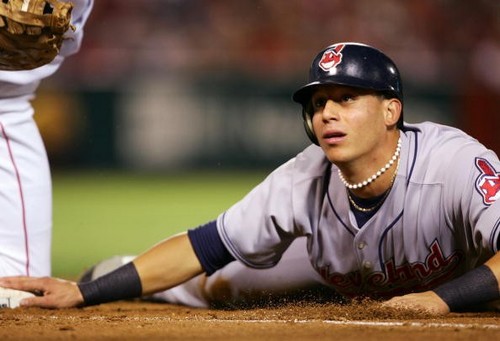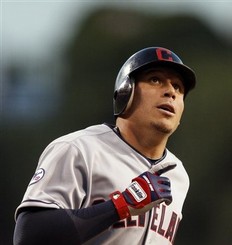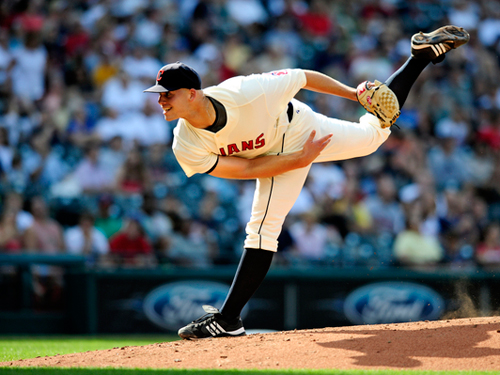 Indians Archive
Indians Archive  Extending a Lazy Sunday
Extending a Lazy Sunday

While the Indians push ever closer to that “goal” of a .500 record (1 win to go) and a 2nd place finish that became the focus of the season after being steamrolled by the Tigers (who steamrolled through the rest of the AL as well), the last week has been an interesting one in the world of baseball as Brad Pitt graces the cover of SI in an A’s hat and as a movie about baseball statistics continues to pack them in at the theaters. Though most baseball fans who come here are familiar (even if vaguely familiar) with the whole “Moneyball” movement, the misconceptions about it, and how it is perceived by those who love it and those who hate it (and those two camps are both full), much of the better analysis of “Moneyball” that’s been coming out since the movie opened has had little to do with the actual book or even the movie.
Rather, what has been the most compelling narrative to follow has been how “Moneyball” has evolved and how it not only has changed the manner in which baseball decisions are made, but the landscape of MLB altogether. For starters, Ken Rosenthal has a terrific piece on how “Moneyball” basically pulled back the curtain on what a few teams were doing when it was written and how the (relative) success of those teams has now caused basically every MLB team to engage in some sort of statistical analysis. Rosenthal delves into what has happened since the release of the book – focusing on specific markets – and attempts to frame it as an evolution, or at least the starting point of a particular evolution.
However, the most compelling piece from the week comes from Tom Verducci in the print edition of SI as Verducci focuses on one market very specifically and how the evolution of the Red Sox, from their statistical analysis, has vaulted Boston into an upper echelon of teams that it is unlikely to leave any time soon. While this is no great revelation, Verducci goes inside what the Red Sox do and how the revenues that they generate separate them from every other team that has leaned on certain philosophies in the past decade. Again, the piece presents no great surprise to people who have been paying attention to the evolution of the Red Sox in the past decade, but Verducci frames it in such a way that he accurately points out how Boston uses their built-in advantages (in the draft, in FA, their ability to overcome mistakes, etc.) because of their revenue streams.
Reading it is pretty sobering as the fan of a small-to-mid-market team that is never going to be able to compete on the consistent basis that the Red Sox have done in the past decade. It also strikes some fear into any Tribe fan’s heart in that it certainly lays out for any large-market, big-revenue team that is NOT taking advantage of the system the way that the Red Sox do to put their current system under the magnifying glass. Since MLB certainly doesn’t seem to be interested in really overhauling the system to prevent the “haves” from becoming further separated from the “have nots” (they prefer to add another Wild Card so the 10 or so teams in each league that don’t get a playoff berth as a birthright have more hope as the season rolls on), it certainly doesn’t elicit a lot of confidence for a team like the Indians, or the other 25 or so other teams in a similar predicament.
So what can the Indians do?
Sure, they can try to make a move with the Marlins, now that Florida’s closer is…um, not who they thought he was, and try to find that RH bat by perhaps dangling Chris Perez to the Fish, who continue to be included on the lists of being “in” on the Pujols/Prince extravaganza (albeit with a heavy dose of skepticism), but the best they can do is hope to get the pieces lined up together every couple of years and take a shot at it.
And isn’t that what they’ve done…and what they’re currently doing?
As much as we hear about “windows” and read about how they are set up for 2012 contention and while everyone knows about the current “window”, what the Indians (or any team like them) need to do is identify a talented group of players, keep them under club control for as long as possible as a group, and hopefully get an extended playoff run (or two) out of that group of players. They did that from 2004 to the middle of 2009 and, while that group only made one playoff run, they’re doing it again, as evidenced by their breakout 2011 season, even if it ended prematurely.
That said, most Tribe fans seem to be looking at this group of players and seeing a fairly limited “window” of opportunity as there are some major pieces that are only under control through the 2013 season (Asdrubal, Ubaldo, Choo) or the 2014 season (Masterson), but if what is past is truly prologue, isn’t this the off-season that the Indians take some of these now-identified “core” players and attempt to keep that window open a little longer by approaching some players that are arbitration-eligible and are only under club control for a couple additional years?
As soul-crushing as it may be to see the usual suspects make the playoffs (NYY, BOS, PHI, TEX) with the rotating group of “see, they can do it” teams (MIL, AZ) after reading those pieces from Rosenthal and Verducci that point out how the already-uneven playing field is probably going to continue to tilt – and not in the Tribe’s favor – the best course of action for the Indians to take this off-season is to take those “core” players that they’ve assembled (via trade or however) and start to approach them about extensions to keep them in Cleveland as long as possible.
They did it in the early-to-mid-1990’s…
They did it in the early-to-mid-2000s…
And, it’s more than likely that they’re going to start doing it this off-season…
While I’m not suggesting the wholesale approach to the whole roster that John Hart and Dan O’Dowd executed in the early-to-mid-1990s (Scott Scudder…Glenallen Hill, anyone?), there is little question that the current group of Indians has some players that need to be approached by the club with offers that guarantee fair salaries for the next few years in order to keep them under club control past what their current service time would dictate.
This was mentioned about a month ago, but the Indians “could approach Asdrubal with an offer similar to the contract that Troy Tulowitzi signed back in 2008 (not the 10-year deal he just inked) for 6-years and $31M just as they could go to Masterson with a deal similar to the ones that Jon Lester (5 years, $30M) and Clay Buchholz (4 years, $29.95M) recently signed to keep those two on The Reservation for the foreseeable future at set contract numbers.”
Let’s keep this line of thinking going, and since I’m using Tulo’s first deal as the basis for a potential Asdrubal extension, let’s rememberwhat was pointed out back in May and re-visit the comparison, as it is worth pointing out again what Tulowitzki put forth in his first 3 MLB seasons as well as what Asdrubal did in his first 3 MLB seasons:
Tulowitzki (2006-2008) – 281 games
.276 BA / .346 OBP / .435 SLG / .781 OPS / 96 OPS+ with 99 XBH in 1,082 AB
Asdrubal (2007-2009) – 290 games
.287 BA / .355 OBP / .411 SLG / .766 OPS / 105 OPS+ with 92 XBH in 1,034 AB
 Now, if you look at what each player did/is doing in their 4th season, you start to wonder if Asdrubal and Tulowitzki are more similar players than one would imagine. By that I mean that here are Tulowitzki’s numbers from that 4th season in 2009, when he was 24 years old:
Now, if you look at what each player did/is doing in their 4th season, you start to wonder if Asdrubal and Tulowitzki are more similar players than one would imagine. By that I mean that here are Tulowitzki’s numbers from that 4th season in 2009, when he was 24 years old:
.297 BA / .377 OBP / .552 SLG / .930 OPS / 131 OPS+ with 32 HR, 66 XBH
And now, Asdrubal’s 4th season this year, which is his season as a 25-year-old:
.275 BA / .334 OBP / .465 SLG / .800 OPS / 121 OPS+ with 25 HR, 60 XBH
There is some age discrepancy there, but what is interesting there is while Tulo’s numbers certainly look better overall, a stat like OPS+ actually says that Asdrubal is having a comparable year in the context of what’s happening offensively in the rest of the league because it uses the rest of MLB as a comparison tool and relates what each player is doing in the context of the rest of MLB.
While realizing that this isn’t apples-to-apples, this is the contract that Tulowitzki signed in January of 2008 which, at the time, was the largest deal ever for a player with less than 2 years of service time, starting with the relevant comparatives of what would have been Tulo’s 2nd year of arbitration and all ensuing years in the contract he signed:
2011 - $5.5M
2012 - $8.25M
2013 - $10M
2014 - $15M club option ($2M buyout)
Whoa…those are some big numbers that are out there, but if (according to MLBTR), “Cabrera’s power surge should push him to $4.9MM or so” in his 2nd year or arbitration, that $5.5M number (or thereabouts) is probably a conceivable carrot to hang out there for Asdrubal to get him to the table for an extension. Of course, Tulowitzki signed his deal, with those locked-in numbers, far earlier in his career than where Asdrubal is right now, so the Indians may need to come pretty close to these numbers.
Given that Tulowitzki has put up better numbers (for longer) than Cabrera but signed his deal much earlier in his career than Asdrubal would, perhaps the Indians could use the last 3 guaranteed years (and one club option) of Tulo’s first contract as a framework to offer Asdrubal a deal that would look something like this:
2012 - $5.5M
2013 - $8.5M
2014 - $10M
2015 - $12M club option ($1M buyout)
2016 - $13M club option ($2M buyout)
That’s a 3-year deal worth $27M guaranteed, buying out one year of Asdrubal’s FA years (2014) and putting some club options in there at big numbers (with buyouts that aren’t inconsequential in terms of cash) that might entice Asdrubal to consider the security of a long-term deal instead of going year-to-year for the next two seasons. Maybe this could be construed as “buying high”, but Asdrubal doesn’t turn 26 until this November and if the assumption is that 2011 finally provided a peek into what Asdrubal can do, it’s the right time to make this kind of commitment to a player, rather than deal with the nightmare that Asdrubal would hit the FA market as a 27-year-old entering his age-28 season and figuring that there would be some interested suitors at that point.
Perhaps Asdrubal is keenly aware of those years and ages and potential interest, but his agent (Alan Nero) also represented Victor Martinez when El Capitan signed a 5-year deal with a club option back in 2005, sacrificing potential future earnings for security, so perhaps a common ground could be located.
The question that needs to be asked is whether approaching Cabrera with a long-term deal with some big numbers going forward is even prudent, given his HUGE bump in production from Asdrubal?
To that I would say that I think too much is being made of his HR increase, particularly as it’s being framed as a one-year bump from his injury-riddled 2010 to his fully-healthy 2011. Consider that in the 1,610 plate appearances that Asdrubal had coming into this year, he had 112 XBH, meaning that he hit an XBH in 6.9% of his plate appearances. This year, he has tallied 60 XBH in 652 PA and while that translates out to him getting an XBH in 9.2% of his plate appearances, we’re not talking about a stratospheric leap here, particularly considering his age and his health.
Could Asdrubal come back to Earth and never replicate his 2011 success?
Of course…don’t you remember Jhonny Peralta v.2005 (.885 OPS as a 23-year-old) and Peralta from 2006 through 2009 (.744 combined OPS over 4 seasons, with a .690 OPS in 2009)?
But these are the risks the Indians need to take (particularly in light of the evolving landscape of MLB), to lock up their own players while they sit alone with them at the negotiating table. When they’re the only team able to offer a player the security of guaranteed money, they need to parlay that into more years of club control, and this off-season represents a perfect time to do so with Asdrubal.
 Asdrubal is not alone on this list however as Justin Masterson’s 2011 season has vaulted him into the upper echelon of AL starters, with his first year of arbitration awaiting him this off-season. Though the MLBTR piece says that Masterson would use a “healthy $4M this year” in arbitration, he would look to be ripe for an extension that would keep the big RHP under club control past 2014. In terms of Masterson and a comparable contract that could provide the framework for an extension for the large RHP that figures in at the top of the rotation, you need to look no further than the deal signed by Masterson’s former Red Sox teammate Clay Buchholz, who signed a 4 years, $30.445M last off-season with 2016 and 2017, with the numbers breaking down like this:
Asdrubal is not alone on this list however as Justin Masterson’s 2011 season has vaulted him into the upper echelon of AL starters, with his first year of arbitration awaiting him this off-season. Though the MLBTR piece says that Masterson would use a “healthy $4M this year” in arbitration, he would look to be ripe for an extension that would keep the big RHP under club control past 2014. In terms of Masterson and a comparable contract that could provide the framework for an extension for the large RHP that figures in at the top of the rotation, you need to look no further than the deal signed by Masterson’s former Red Sox teammate Clay Buchholz, who signed a 4 years, $30.445M last off-season with 2016 and 2017, with the numbers breaking down like this:
2012 - $3.5M
2013 -$5.5M
2014 - $7.7M
2015 - $12M
2016 - $13M club option ($0.245M buyout)
2017 - $13.5M club option ($0.5M buyout)
You’ll notice that Buchholz’s contract (signed this past April) does not include a 2011 salary as it included a $1M signing bonus in addition to the $550K he made in 2011 from Boston as the contract really goes into effect in 2012
That’s interesting because when Buchholz signed that extension prior to the 2011 season, he had 2 years and 59 days of service time and (after this season) Masterson will have 3 years and 108 days of service time, meaning that he’s 1 year further into his career than Buchholz was when he signed his deal. However, if Buchholz’s contract didn’t offer him a significant pay bump in 2011, I don’t think that it’s outrageous to copy the pattern of the Buchholz extension and maybe bump up those numbers accordingly, figuring the leap that Masterson took
The leap is one that Buchholz took a year earlier and one of the reasons that Buchholz is the one being used here is because his 2010 season (the one before his extension) was similar to Masterson’s 2011 season as Buchholz broke out in 2010, to the tune of a 2.33 ERA, a 1.20 WHIP, and a MLB-best 187 ERA+. Similarly, Masterson has answered questions about his viability as a front-of-the-rotation starter, en route to a 3.21 ERA, 1.28 WHIP, and a 123 ERA+. Certainly, Buchholz’s 2010 numbers are more impressive than those from Masterson this year, but with Masterson closer to FA than Buchholz was last off-season, it is possible that Masterson is going to be looking for numbers similar to those received by Buchholz last April.
Perhaps the Indians could do something similar to Buchholz’s deal with something like this, particularly figuring that “guess” from MLBTR on Masterson’s 2012 salary via arbitration:
2012 - $4M
2013 - $6M
2014 - $8M
2015 - $12M
2016 - $13M club option ($250K buyout)
2017 - $14M club option ($500K buyout)
That breaks down to a 4-year, $30.75M deal for Masterson (with the $30.75M guaranteed) with club options that could keep him in a Tribe uniform through the 2017 season, when Masterson will be 32. Essentially, they’d be buying out one year of FA (and paying him $12M in that year) with some club options that represent some pretty big numbers after that. He’d be guaranteed the $30.75M, which is more in guaranteed money than the extensions meted to Buchholz and another former teammate, Jon Lester, both of whom signed extensions with Boston prior to arbitration, giving up years of FA and with club options attached to the extensions for the security of guaranteed money.
 Would Masterson do something similar?
Would Masterson do something similar?
It’s entirely possible and it would lock in numbers for a front-of-the-rotation starter and keeps him past that “END OF 2014” that has everyone gripping.
Regardless of whether they’re able to reach an agreement for an extension with Masterson or Cabrera (or even Choo…though I’ve pretty much written that off because of the Boras factor – bad season/DUI or not), it is worth mentioning in all of this extension talk as most people think that keeping homegrown players around is the best use for 2012 money, but extending these guys wouldn’t really affect the 2012 payroll as these players are going to get the salaries (whether it be via arbitration or extension) one way or another.
That’s a common misperception that needs to be cleared up as extending these guys doesn’t really affect their ability to spend money elsewhere for 2012 as the Indians aren’t going to give Justin Masterson $8M in 2012 as part of an extension if he would get around $4M in arbitration because…well, that just isn’t how the process works. Rather, these extensions affect FUTURE payrolls, just as the extensions that were signed back in the early-to-mid-2000s didn’t really affect one particular year (see how the graph in the middle of this page has a nice, linear path up from 2004 to 2009), but kept that group of players together longer than they would have, had the Indians not extended those players that they identified as “core” players back in the early-to-mid-2000s.
Lest you forget, Victor signed a 5-year, $15.5M deal with the Tribe with that 2010 club option back in April of 2005 as Victor was under contract from 2002 through 2010 as an Indian. Obviously, he never made it through that 2009 season, but that’s 9 seasons that El Capitan would have been under club control. Lee was also under club control for 9 seasons as an Indian because of that 2010 club option that was exercised as a member of the Mariners. No, they weren’t 9 FULL seasons, but the Indians gave out extensions to those players that kept them under club control longer than simply going year-to-year with them in arbitration, then dealing with their FA year when it arrived would have.
Anyone remember that CC was under club control for 8 years as an Indian because of the TWO extensions that he signed with Cleveland?
Again, while most people remember how these guys LEFT because of contracts, they forget that the Indians extended CC, Lee, Martinez, Sizemore, Peralta (and others) when each was a young player and, while most people don’t remember those deals – remembering instead the “deals” that took them out of Cleveland or the “deals” they signed once they were FA – this is a strategy that the Indians have been implementing since the early 1990s.
While the landscape of the MLB has changed (and will continue to), the Indians can still identify those “core” players and attempt to lock them up in long-term deals that guarantees money to the player, providing the incentive to the player to give up a year or two (or more) of their FA years. Certainly, that doesn’t mean that they need to get overly ambitious and go after Santana or Kipnis or anyone else that is a LONG way away from even being arbitration-eligible. But Cabrera and Masterson are two players that I would certainly approach this off-season to start to get these guys under club control past the end of the 2013 season (in Asdrubal’s case) or the end of the 2014 season (in the case of Masterson) as they seem to have some payroll flexibility going forward.
Having those two players past their current Cleveland “expiration dates” may not be enough to allow the Indians to overcome a slanted system (and not in their favor) where the mousetrap that they built in the mid-2000s has been copied by teams with deeper pockets, now in possession of bigger mousetraps. However, the “core” players for the Indians started to emerge in 2011 and keeping those players on the corner of Carnegie and Ontario as long as they can needs to be as important as anything that the organization is going to do to augment the current group in place to keep that “window” open as long as possible.
- NBA Announces 2013-2014 Schedule
- Browns Ink Sharknado
- Sharknado A No-Show For Rookie Camp
- Trent Richardson Out Until Training Camp
- Browns Sign Brandon Jackson
- Carrasco Suspended Eight Games
- Browns Add to Wide Receiver Depth with David Nelson
- Browns Need to Learn from Past Draft Mistakes
- Browns Release Chris Gocong and Usama Young
- Browns Missing on Grimes Disappointing, But Not The End
The TCF Forums
- Chris Grant's first 3 drafts
Kingpin74 (Tuesday, January 21 2014 10:13 AM) - The 2014 Offseason Thread
googleeph2 (Tuesday, January 21 2014 9:36 AM) - 2015 Recruiting
furls (Tuesday, January 21 2014 6:57 AM) - Mike Brown
YahooFanChicago (Monday, January 20 2014 11:15 PM) - Movies coming out
HoodooMan (Monday, January 20 2014 9:34 PM) - 2014 Hoops Hockey Hijinx
jpd1224 (Monday, January 20 2014 4:44 PM) - 2014 Recruiting
jclvd_23 (Monday, January 20 2014 2:26 PM) - Wish List - #4 Pick
Hikohadon (Monday, January 20 2014 1:26 PM) - Official- Browns Coach Search/Rumors
OldDawg (Sunday, January 19 2014 6:48 PM) - #1 overall pick Anthony Bennett
TouchEmAllTime (Sunday, January 19 2014 1:28 PM)



